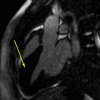Loperamide Toxicity Revealing Apical Hypertrophic Cardiomyopathy
- PMID: 34104323
- PMCID: PMC8158447
- DOI: 10.14797/VRZW9460
Loperamide Toxicity Revealing Apical Hypertrophic Cardiomyopathy
Abstract
Loperamide, a μ-opioid receptor agonist, can cause cardiotoxicity by inhibiting the potassium ion channel and slowing cardiomyocyte repolarization. This, in turn, can lead to frequent early afterdepolarizations, the most common mechanism of drug-induced long QT syndrome and torsades de pointes. Apical hypertrophic cardiomyopathy (AHCM) is a nonobstructive hypertrophic cardiomyopathy rarely associated with malignant arrhythmias. We present a case of loperamide-induced malignant ventricular arrhythmia revealing underlying AHCM in a 25-year-old woman with a history of sudden cardiac arrest (SCA) and opioid use. It is important to evaluate for structural heart disease in all patients presenting with SCA, regardless of presumed etiology such as drug-induced cardiotoxicity, to prevent missed opportunities for adequate treatment. Furthermore, the diagnosis of AHCM in SCA warrants further genetic evaluation for variances with a predilection for malignant arrhythmias.
Keywords: apical hypertrophic cardiomyopathy; loperamide; structural heart disease; sudden cardiac arrest; ventricular tachycardia.
Conflict of interest statement
The authors have completed and submitted the Methodist DeBakey Cardiovascular Journal Conflict of Interest Statement and none were reported.
Figures



References
-
- Klarich Kyle W., Attenhofer Jost Christine H., Binder Josepha, Connolly Heidi M., Scott Christopher G., Freeman William K., Ackerman Michael J., Nishimura Rick A., Tajik A. Jamil, Ommen Steve R. The American Journal of Cardiology. 12. Vol. 111. Elsevier BV; 2013. Risk of Death in Long-Term Follow-Up of Patients With Apical Hypertrophic Cardiomyopathy; pp. 1784–1791. - DOI - PubMed
Publication types
MeSH terms
Substances
LinkOut - more resources
Full Text Sources
Medical
Research Materials

